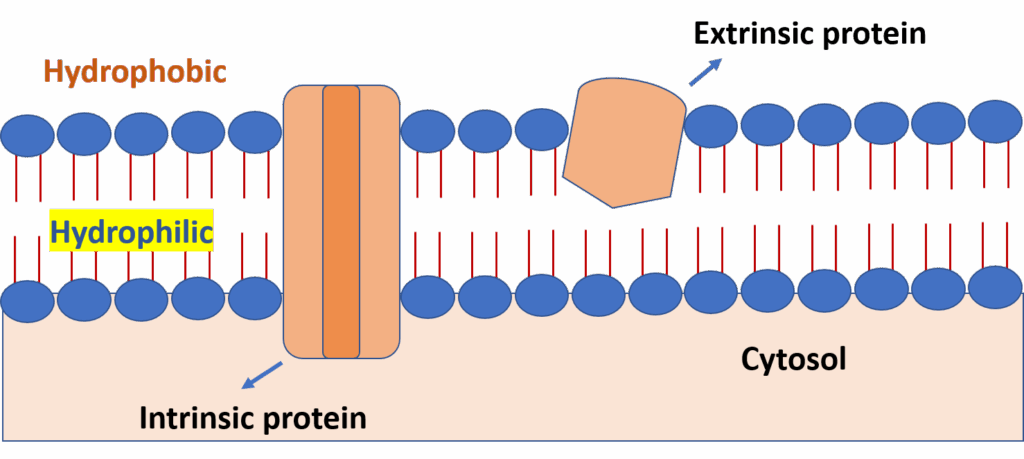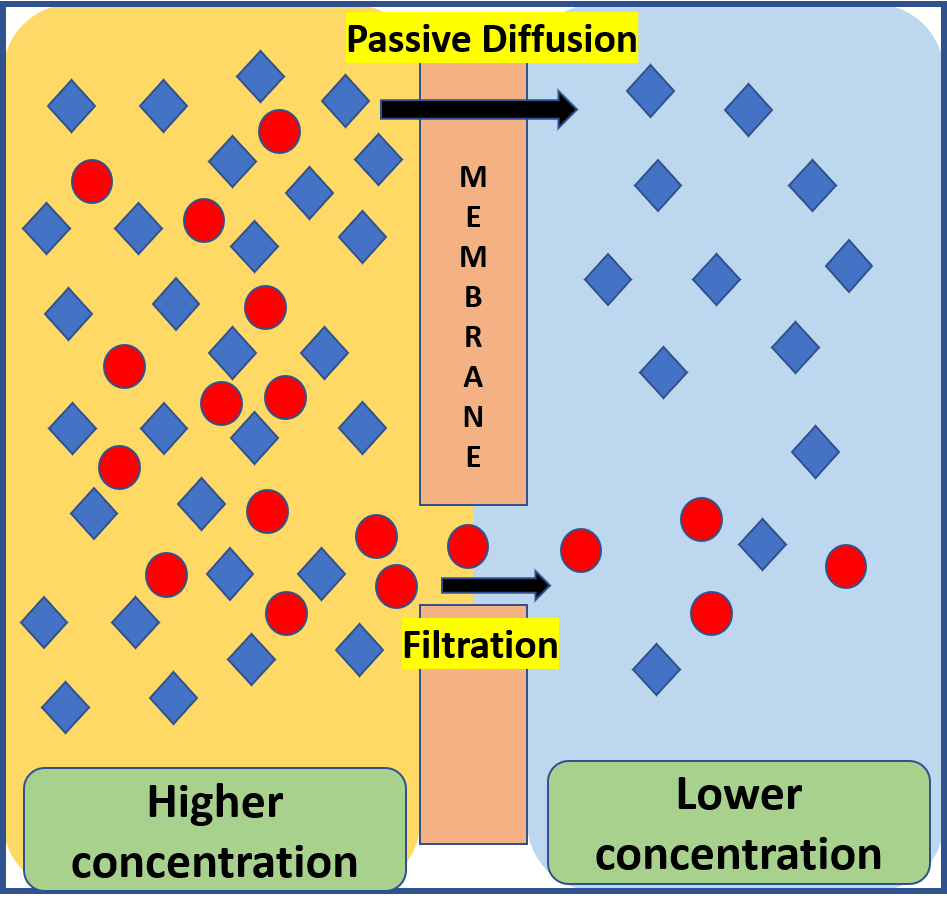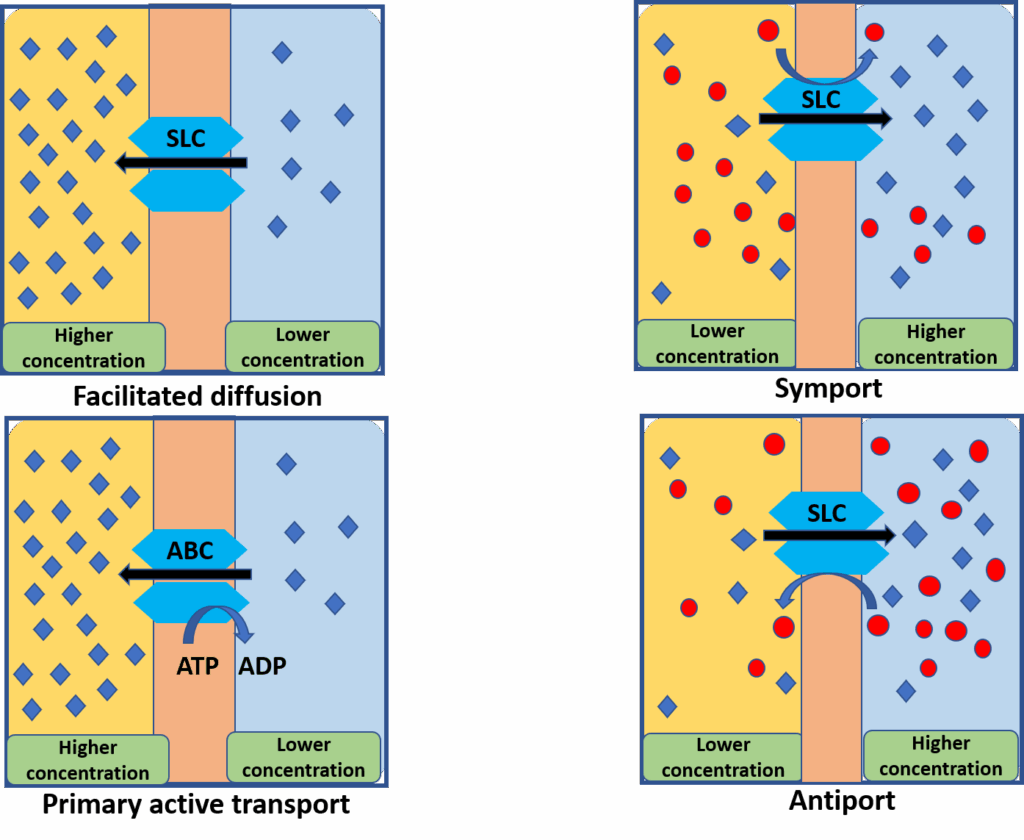Pharmacokinetics: Membrane Transport
Pharmacokinetics is the branch of pharmacology that studies how drugs move through the body. It covers how a drug gets into the body, where it goes, how long it stays, and how it leaves. The strength of a drug’s effect depends on how much of it reaches the site where it is supposed to work. This is controlled by the drug’s pharmacokinetics. So, understanding pharmacokinetics helps us decide how to give the drug (by mouth, injection, etc.), how much to give, how long it takes to start working, how long it lasts, and how often it should be taken.
All these processes involve drug transport across biological membranes, which act as barriers in the body.
What Is a Biological Membrane?
A biological membrane is a thin layer made mostly of fat (lipids) and proteins. It is about 100 angstroms thick (very thin!). These lipids are arranged in two layers, called a bilayer, and have a special structure: the “head” parts (polar) are water-loving and face the outer surfaces, while the “tail” parts (non-polar) are water-fearing and point inward, forming a barrier.

The membrane also contains proteins that can float around and move. These proteins can act as enzymes, carriers, receptors, or channels. Some proteins form small pores through which water or very small molecules can pass. The structure of the membrane is flexible and always changing. This makes it dynamic and selective in allowing what can go through.
How Drugs Cross Membranes
Drugs can move across biological membranes in two main ways:

- Passive diffusion and filtration
- Specialized (or active) transport
1. Passive Diffusion
This is the most common way drugs move across membranes. It means the drug moves from a place where there is more of it to a place where there is less, without using energy. The membrane doesn’t do anything special; the drug just slips through it.

Drugs that are lipid (fat) soluble can easily pass through the membrane. The more lipid-soluble a drug is, the faster it moves across. Also, the bigger the difference in concentration on the two sides, the faster the drug moves.
Effect of pH and Ionization
Most drugs are weak acids or weak bases. This means they can change between ionized (charged) and unionized (uncharged) forms depending on the pH (acidity or alkalinity) of their environment. Only the unionized (uncharged) form can easily cross membranes.
- Weak acids (like aspirin) are mostly unionized in acidic environments like the stomach, so they are absorbed there.
- Weak bases (like atropine) are mostly unionized in basic environments like the small intestine and are absorbed there.
This can lead to something called ion trapping, where a drug crosses into a part of the body with a different pH, changes to its ionized form, and gets “trapped” there. For example, aspirin can damage the stomach lining because it gets trapped inside the stomach cells.
Filtration
This is the movement of small drug molecules through tiny water-filled pores in the membrane or between cells. If the drug is small and water-soluble, and if the pores are large enough, it can pass through.
This process is important in places like:
- Capillaries (tiny blood vessels), where drugs can move into and out of the bloodstream.
- Kidneys, where drugs are filtered out of the blood.
In most tissues, the size of the pores is very small, so only very small molecules can pass. But in organs like the liver and kidneys, the pores are larger, allowing more drugs to pass through.
2. Specialized (or Carrier-Mediated) Transport
Some drugs need help to cross membranes. This help comes from carrier proteins in the membrane.

There are two main types of carrier transport:
a. Facilitated Diffusion
- Does not require energy.
- The carrier protein helps a drug move from high to low concentration.
- Example: Glucose entering muscle cells through the GLUT-4 transporter.
This type of transport is specific to certain molecules and can become saturated (the transporter gets full and can’t carry more until it’s free again).
b. Active Transport
- Requires energy, usually from ATP.
- Moves drugs from low to high concentration (against the gradient).
- Can concentrate drugs in certain parts of the body.
There are two types of active transport:
i. Primary Active Transport
- Directly uses ATP as energy.
- Carried out by special proteins called ABC transporters (ATP Binding Cassette).
- These transporters often push drugs out of cells.
- Example: P-glycoprotein (P-gp) pushes out harmful drugs and toxins, often found in the gut, brain, liver, and kidneys.
ii. Secondary Active Transport
- Uses energy indirectly.
- It relies on the movement of another molecule (like sodium) to push the drug across.
- If both move in the same direction, it’s called symport.
- If they move in opposite directions, it’s called antiport or exchange transport.
These transporters also play a big role in how drugs are absorbed, distributed, and removed from the body. For example, the amino acid transporter helps absorb drugs like levodopa (used in Parkinson’s disease).
Saturation and Genetics
Carrier transport systems can become full or saturated. The maximum rate of transport depends on how many transporters are present. Also, these transporters can be affected by genetics. Some people may have more or fewer of a certain transporter, or their transporters may work better or worse. This can affect how well a drug works or how long it stays in the body.
Pinocytosis
This is a less common method of drug transport. The cell forms a small pocket around the drug, swallows it, and forms a vesicle inside. This process is used for large molecules like vitamin B12, which needs to bind to a protein called intrinsic factor to be absorbed in the intestine.
Conclusion
Understanding how drugs cross membranes is key to knowing how they work in the body. Passive diffusion is the most common method, but for many drugs, especially larger or less lipid-soluble ones, specialized transport is needed. Factors like pH, ionization, and presence of transporters affect how well and where a drug is absorbed, how fast it reaches its target, and how quickly it is removed. These processes are important in designing effective and safe medications.
References
Latest Editions of
- Rang H. P., Dale M. M., Ritter J. M., Flower R. J., Rang and Dale’s Pharmacology,.Churchil Livingstone Elsevier
- K.D.Tripathi. Essentials of Medical Pharmacology, JAYPEE Brothers Medical Publishers (P) Ltd, New Delhi.
- Sharma H. L., Sharma K. K., Principles of Pharmacology, Paras medical publisher
